Studies to improve growth rate carried out at IFREMER-Tahiti
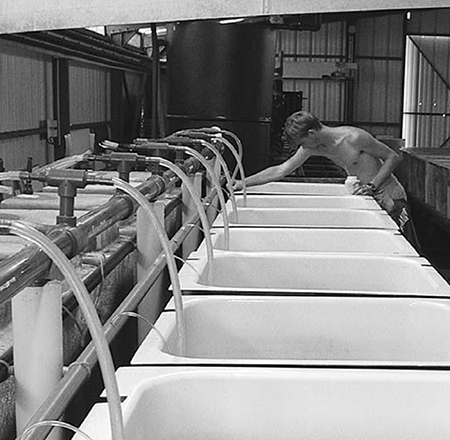
Mass selection studies with a domesticated strain of Penaeus stylirostris to improve growth rate have been carried out since 1992 at IFREMER-Tahiti in French Polynesia. The selected line was graded once or twice by generation, with a selection rate ranging from 4 percent to 18 percent in the successive generations (Fig. 1) while a non-selected line was maintained as a control. At the fourth generation growth improvements became statistically significant, with an 18 percent growth improvement compared to the control line. At the sixth generation, additional experiments were conducted in order to characterize differences between the selected and the control lines on several traits (FCR, osmoregulation capacity and others) that could have been affected by selecting only for growth.
Growth, feed consumption, conversion
Eighty animals (141 days old) from each line were randomly chosen in the earthen pond where they were growing. They were individually marked with colored plastic elastomer implants and then sexed and weighed. For each line, eight sets of ten shrimp were randomly distributed into sixteen 0.25-m2 tanks, with lagoon filtered seawater (~28 degrees C a.m.) and maintained under constant dissolved oxygen levels and water exchange. Animals were fed twice daily at 4 percent BW per day, and rates were constantly adjusted to feed to excess. Feed not consumed was collected, dried and weighed.
Growth
Animals were individually weighed again four weeks later. Animals averaged 16.5 grams at the beginning of the experiment, with no significant differences between the lines. Two sets of ten selected individuals were accidentally lost during the first experiment. By the end of the experiment, the two strains demonstrated significant differences in growth for each sex, with a mean improvement of 35 percent of this sixth selection generation relative to the control line (Figs. 2, 3).
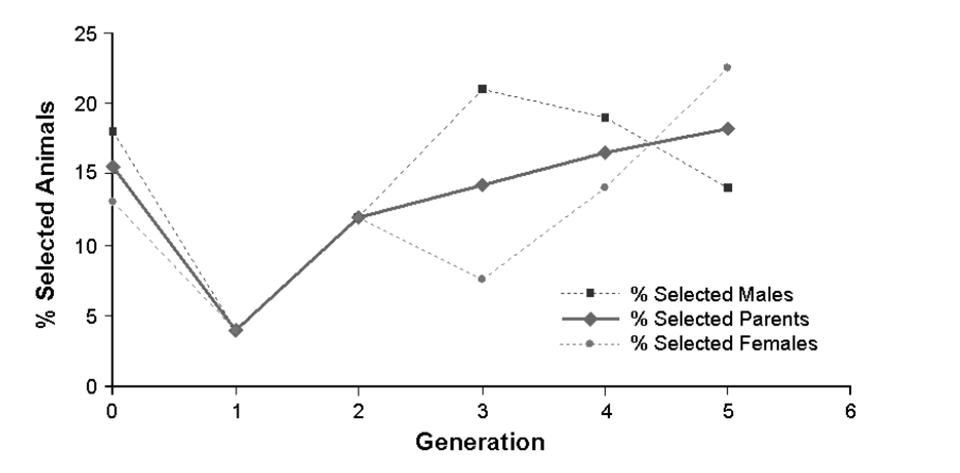
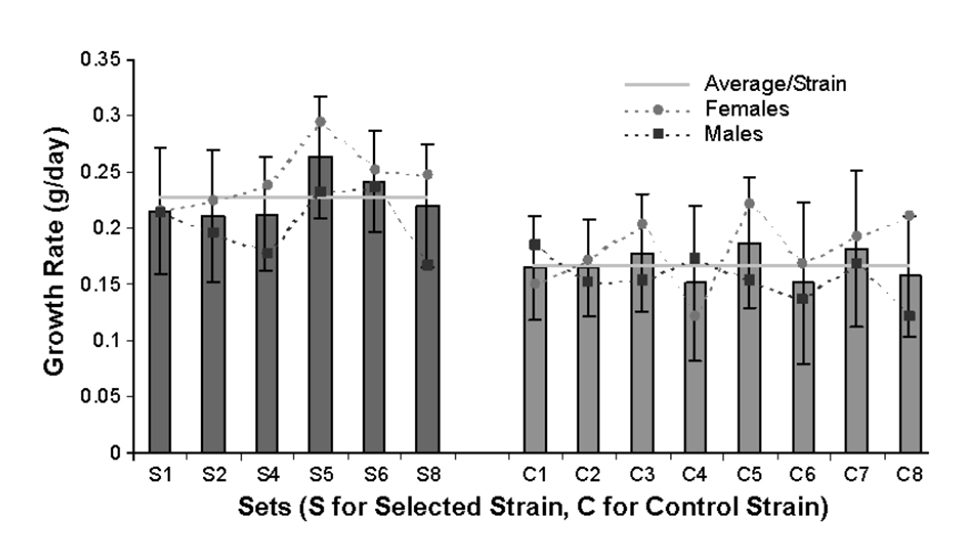
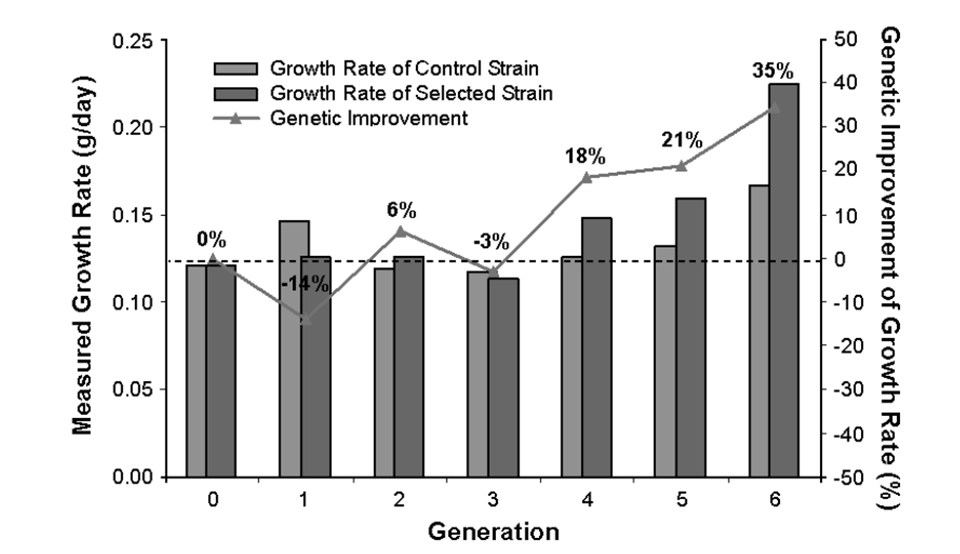
Feed consumption, conversion
Feed consumption and feed conversion ratios (FCR) were calculated for five selected sets and six control sets (those with at least 80 percent survival rate). Differences in feed consumption were not statistically significant between the strains. The FCR results showed particularly high rates (approximately 10:1) relative to what should be theoretically expected (about 2:1 in farms), but under experimental and not farm conditions (no natural productivity; experiment animals typically eat more than strictly necessary for growth; and tank confining and density could refrain potential growth expression). Under these experimental conditions, FCR was significantly 25 percent better (lower) for the selected line. This may indicate slight differences in the ability of the two strains to convert feed (Fig. 4).
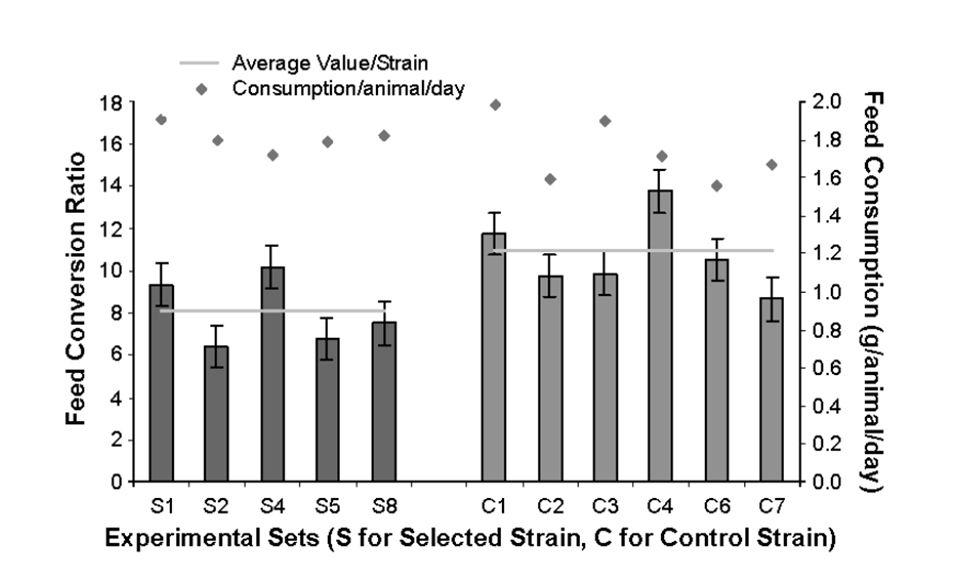
Digestibility
Animals used for this second experiment were chosen at random among those used in the growth monitoring. For each strain, two replicates of 21 individuals were reared in 1.2-square-meter tanks. Shrimp were fed a Celite®-marked feed four times daily, to calculate Apparent digestibility coefficient (ADC) of proteins for each tank. Acid insoluble ash from the Celite was used as a digestion indicator, measured according to Atkinson et al (1984):
Feces were collected one hour after feeding and then freeze-dried before analysis. No significant difference in protein digestibility was demonstrated between the two populations, but we believe that carbohydrate digestibility should be tested in the future.

Osmoregulation
Animals used for this third experiment were also selected among those survivors of the growth study. To evaluate their capacity to osmoregulate in response to environmental stresses, shrimp in “C” and “D0” molt stage were subjected to combined salinity/temperature shock (temperature dropped from 28 degrees-C to 17 degrees-C for 12 hours, then salinity decreased from 35 percent to 13 percent for 24 hours). Haemolymph samples were collected after an eight-hour starvation period. Haemolymph was sampled with a needle of a 1-ml hypodermic syringe inserted into the sinus of the cephalothorax.
The osmoregulatory capacity is the difference between the haemolymph osmolarity and the external medium osmolarity. Osmolarity was measured with a vapor pressure osmometer, utilizing a 10µl sample on a 6.35-mm-diameter filter paper disc. No significant difference was observed between the strains, although there was a slightly higher osmotic capacity for the selected strain.
Conclusion
The selected strain had growth rate 34 percent higher than the control line. Selection events for a defined trait could have affected other traits, either by “foundation effect” (selected animals in each generation are only a sample of genes within the whole population, and this indirect selection of other genes occurs randomly), or by “hitchhiking” (genetic linkage with the selected character). These experiments suggest selection for growth could have positive effects on feed conversion, but did not affect such unrelated traits as protein digestibility and osmoregulation capacity. Genetic metabolism of the two strains should be investigated further.
Note: Cited references are available from the first author.
(Editor’s Note: This article was originally published in the October 2001 print edition of the Global Aquaculture Advocate.)
Now that you've reached the end of the article ...
… please consider supporting GSA’s mission to advance responsible seafood practices through education, advocacy and third-party assurances. The Advocate aims to document the evolution of responsible seafood practices and share the expansive knowledge of our vast network of contributors.
By becoming a Global Seafood Alliance member, you’re ensuring that all of the pre-competitive work we do through member benefits, resources and events can continue. Individual membership costs just $50 a year.
Not a GSA member? Join us.
Authors
-
E. Goyard
IFREMER, Centre Oceanologique du Pacifique
BP7004, 98719 Taravao
Tahiti, French Polynesia
[114,102,46,114,101,109,101,114,102,105,64,100,114,97,121,111,103,101]
-
L. Penet
IFREMER, Centre Oceanologique du Pacifique
BP7004, 98719 Taravao
Tahiti, French Polynesia -
L. Chim
IFREMER, Centre Oceanologique du Pacifique
BP7004, 98719 Taravao
Tahiti, French Polynesia -
G. Cuzon
IFREMER, Centre Oceanologique du Pacifique
BP7004, 98719 Taravao
Tahiti, French Polynesia -
E. Bédier
IFREMER, Centre Oceanologique du Pacifique
BP7004, 98719 Taravao
Tahiti, French Polynesia -
D. Bureau
Fish Nutrition Research Laboratory
Department of Animal and Poultry Science
University of Guelph – Guelph, Ontario, Canada
Related Posts
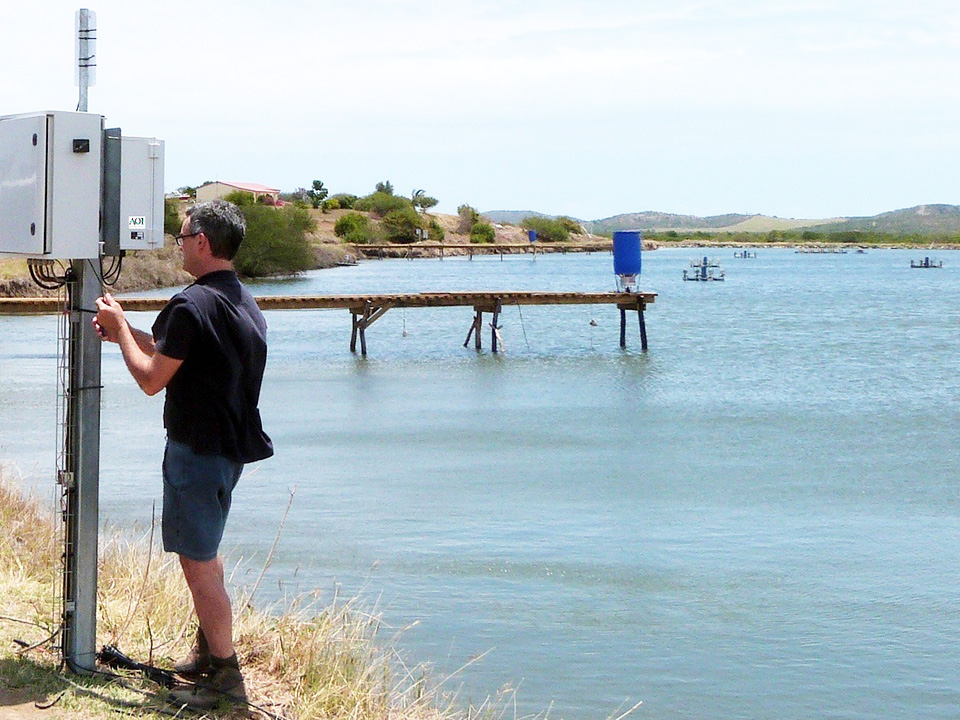
Innovation & Investment
Acoustic control improves feeding productivity at shrimp farms
In systems recently developed for shrimp farms, passive acoustic-based technology enables sensor-based control of multiple automatic feeders. Improved growth and feed conversion have been recorded at commercial farms using the technology.
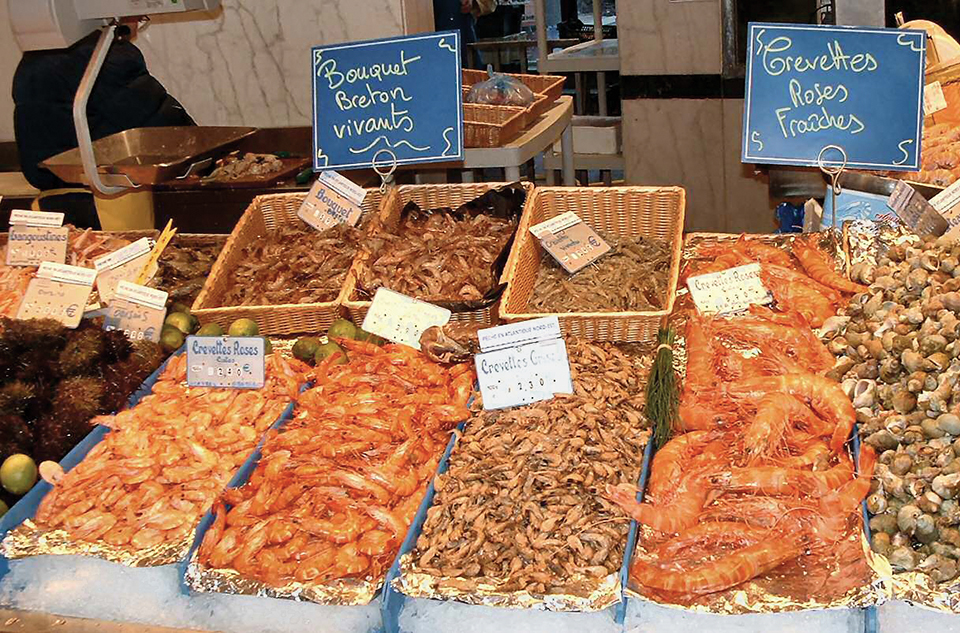
Health & Welfare
Alfalfa concentrate: natural shrimp color enhancer
Adding alfalfa concentrate containing natural carotenoids and pigments to the finishing diets of shrimp can enhance coloration of shrimp after cooking.
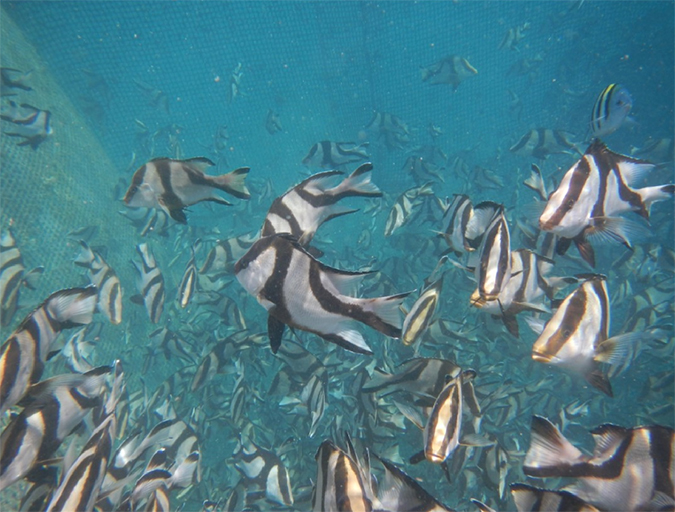
Responsibility
Assessing culture potential of red emperor snapper in New Caledonia
The red emperor snapper, known as “pouatte” in New Caledonia, is valuable throughout its broad geographic range and a highly valued food fish locally. Declining wild catches and market demand have provided the incentive to carry out technical feasibility studies to determine its commercial aquaculture potential.
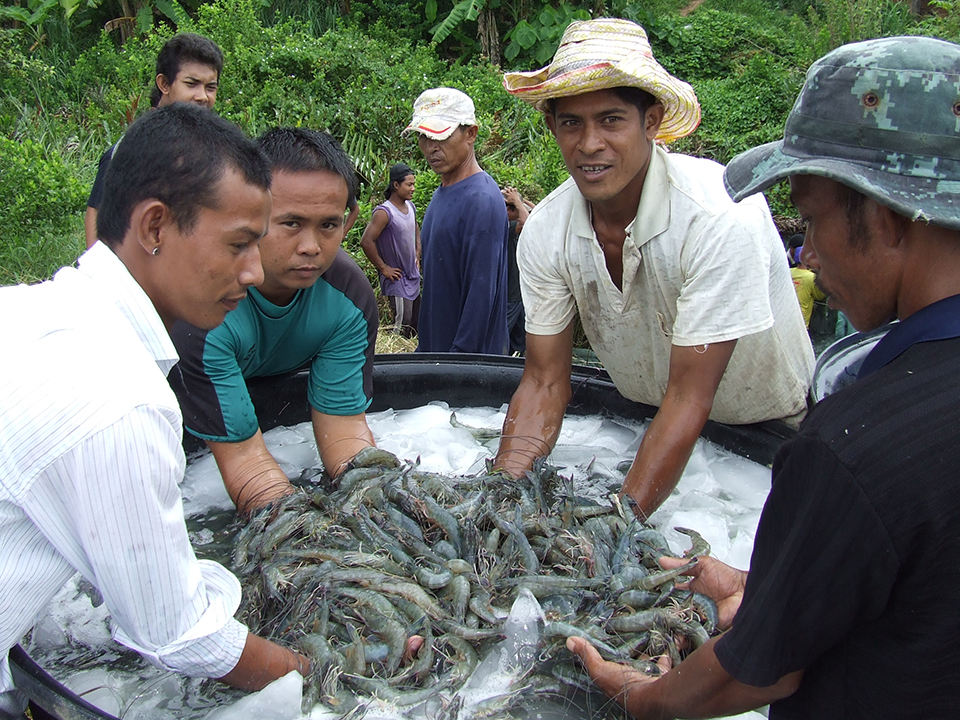
Health & Welfare
Blue alternative: High Health introduces SPF blue shrimp to Thailand
Blue shrimp are very similar to Pacific white shrimp, and can be raised under similar conditions. Blues grow faster and tolerate lower water temperatures.


